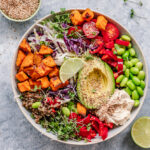by: December 24, 2024
 (NaturalHealth365) What if the secret to eternal youth isn’t hidden in some mystical spring but right on your dinner plate? While explorers once sailed the seas searching for the legendary fountain of youth, scientists have discovered something far more extraordinary: the power to slow aging may be as simple as diversifying what we eat.
(NaturalHealth365) What if the secret to eternal youth isn’t hidden in some mystical spring but right on your dinner plate? While explorers once sailed the seas searching for the legendary fountain of youth, scientists have discovered something far more extraordinary: the power to slow aging may be as simple as diversifying what we eat.
New research published in Frontiers reveals that your everyday food choices could be the key to a longer, more vibrant life. A varied diet activates powerful biological mechanisms that combat aging at the cellular level through reduced oxidative stress. It seems that the fountain of youth has been in our kitchens all along.
The surprising science of aging and diet
Chronic disease drives aging, but recent research suggests a surprisingly simple way to slow it down. The study referenced above found that people who eat a wide variety of foods tend to age more slowly at the cellular level.
The research team analyzed 22,600 people, looking at their eating across five major food groups divided into 18 subcategories. Each person received a dietary diversity score based on their eating patterns. The researchers then compared these scores to aging markers in their blood.
People who ate more varied diets showed clear signs of slower aging. Their blood tests revealed lower levels of glutamyltransferase (GGT), a protein that indicates cellular stress. Their inflammation markers also dropped, with decreased white blood cell counts and better immune cell ratios.
The benefits of diverse eating stem from how different foods interact in the body. While red meat might accelerate aging, whole grains, vegetables, fruits, nuts, and fish help counteract inflammation, which speeds up the process.
Eating the same healthy foods day after day isn’t enough. The body needs a mix of nutrients from different sources. Each food contributes unique protective compounds that help shield cells from damage over time.
The researchers did not claim that varied diets directly cause slower aging. Still, the evidence suggests that eating a broader range of foods helps protect our cells as we age. This approach could help prevent chronic diseases like depression and muscle loss, which often accompany aging.
Tips and strategies to enhance the diversity of your diet
How many different foods did you eat this week? Time to mix it up!
If you are stuck in a rut of eating the same foods repeatedly, pause for reflection. Perhaps you are busy, locked into a routine, or don’t want to try new foods. Make a concerted effort to increase your dietary diversity, and you’ll age slower, mitigate chronic disease, and feel better.
Incorporate diverse foods from the five food groups: organic fruits and vegetables, high quality proteins, raw dairy, fats, and carbohydrates. Examples of diverse fruits and vegetables include raw carrots, cucumbers, apples, peppers, and squash.
Dairy diversity includes organic yogurt, cottage cheese, raw milk, and pasture raised eggs. Carbohydrate diversity highlights include organic brown rice, millet or quinoa. Examples of diverse proteins may include organic lentils, peas, tofu, wild fish, and pasture raised chicken.
If you aren’t excited by the prospect of a diverse diet, gamify your consumption with the Rainbow Plate Challenge. Eating a rainbow isn’t just fun – it’s the secret to aging vibrantly!
The Rainbow Plate Challenge centers on eating a wide array of organic, non-GMO vegetables and fruits for improved health. Strive to add all the colors of the rainbow to your plate throughout the day, and your body will feel better and age slower.
Sources for this article include:
No hay comentarios:
Publicar un comentario